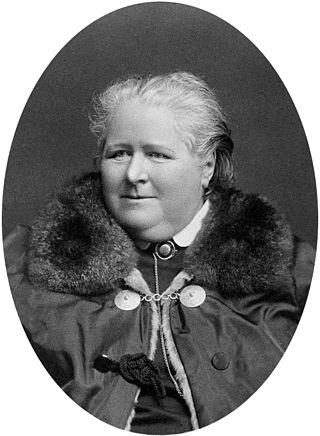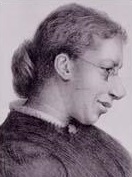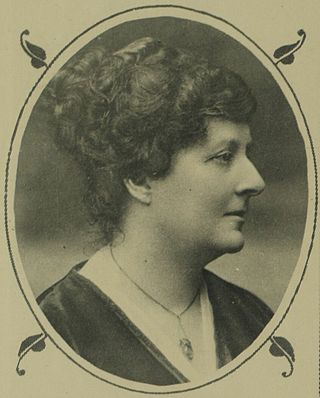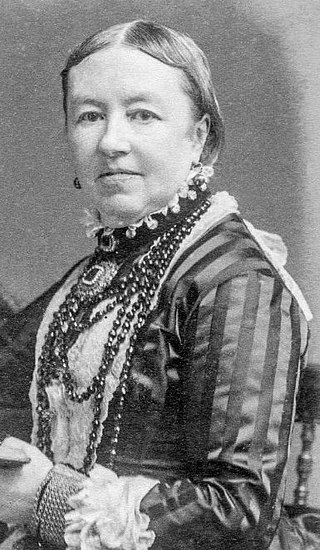Related Research Articles

Dame Millicent Garrett Fawcett was an English political activist and writer. She campaigned for women's suffrage by legal change and in 1897–1919 led Britain's largest women's rights association, the National Union of Women's Suffrage Societies (NUWSS), explaining, "I cannot say I became a suffragist. I always was one, from the time I was old enough to think at all about the principles of Representative Government." She tried to broaden women's chances of higher education, as a governor of Bedford College, London and co-founding Newnham College, Cambridge in 1875. In 2018, a century after the Representation of the People Act, she was the first woman honoured by a statue in Parliament Square.

Frances Power Cobbe was an Anglo-Irish writer, philosopher, religious thinker, social reformer, anti-vivisection activist and leading women's suffrage campaigner. She founded a number of animal advocacy groups, including the National Anti-Vivisection Society (NAVS) in 1875 and the British Union for the Abolition of Vivisection (BUAV) in 1898, and was a member of the executive council of the London National Society for Women's Suffrage.

Lydia Ernestine Becker was a leader in the early British suffrage movement, as well as an amateur scientist with interests in biology and astronomy. She established Manchester as a centre for the suffrage movement and with Richard Pankhurst she arranged for the first woman to vote in a British election and a court case was unsuccessfully brought to exploit the precedent. Becker is also remembered for founding and publishing the Women's Suffrage Journal between 1870 and 1890.

The United Procession of Women, or Mud March as it became known, was a peaceful demonstration in London on 9 February 1907 organised by the National Union of Women's Suffrage Societies (NUWSS) in which more than 3,000 women marched from Hyde Park Corner to the Strand in support of women's suffrage. Women from all classes participated in what was the largest public demonstration supporting women's suffrage seen until then. It acquired the name "Mud March" from the day's weather since incessant heavy rain left the marchers drenched and mud-splattered.

The National Society for Women's Suffrage was the first national group in the United Kingdom to campaign for women's right to vote. Formed on 6 November 1867, by Lydia Becker, the organisation helped lay the foundations of the women's suffrage movement.

A movement to fight for women's right to vote in the United Kingdom finally succeeded through acts of Parliament in 1918 and 1928. It became a national movement in the Victorian era. Women were not explicitly banned from voting in Great Britain until the Reform Act 1832 and the Municipal Corporations Act 1835. In 1872 the fight for women's suffrage became a national movement with the formation of the National Society for Women's Suffrage and later the more influential National Union of Women's Suffrage Societies (NUWSS). As well as in England, women's suffrage movements in Wales, Scotland and other parts of the United Kingdom gained momentum. The movements shifted sentiments in favour of woman suffrage by 1906. It was at this point that the militant campaign began with the formation of the Women's Social and Political Union (WSPU).

Helen Bright Clark (1840–1927) was a British women's rights activist and suffragist. The daughter of a radical Member of Parliament, Clark was a prominent speaker for women's voting rights and at times a political realist who served as a mainstay of the 19th century suffrage movement in South West England. A liberal in all senses, Clark aided progress toward universal human brotherhood through her activities in organisations which assisted former slaves and aboriginal peoples.

Ray Strachey was a British feminist politician, artist and writer.

Jessie Chrystal Macmillan was a suffragist, peace activist, barrister, feminist and the first female science graduate from the University of Edinburgh as well as that institution's first female honours graduate in mathematics. She was an activist for women's right to vote, and for other women's causes. She was the second woman to plead a case before the House of Lords, and was one of the founders of the Women's International League for Peace and Freedom.

Lady Frances Balfour was a British aristocrat, author, and suffragist. She was one of the highest-ranking members of the British aristocracy to assume a leadership role in the Women's suffrage campaign in the United Kingdom. Balfour was a member of the executive committee of the National Society for Women's Suffrage from 1896 to 1919. As a non-violent suffragist, she was opposed to the militant actions of the Women's Social and Political Union, whose members were called the suffragettes.

Helen Blackburn was a feminist, writer and campaigner for women's rights, especially in the field of employment. Blackburn was an editor of the Englishwoman's Review magazine. She wrote books about women workers and a history of the women's suffrage movement in Britain and Ireland which became the "standard work". She served as secretary of the National Society for Women's Suffrage and the West of England Suffrage Society, and co-founded the Freedom of Labour Defence League. Her name appears on the plinth of the Millicent Fawcett statue in Parliament Square.

Agnes Garrett was an English suffragist and interior designer and the founder in 1888 of the Ladies Dwellings Company.

Nessie Stewart-Brown JP was a British suffragist and Liberal Party politician. Her name and picture is on the plinth of the statue of Millicent Fawcett in Parliament Square.

Priscilla Bright McLaren was an English activist who served and linked the anti-slavery movement with the women's suffrage movement in the nineteenth century. She was a member of the Edinburgh Ladies' Emancipation Society and, after serving on the committee, became the president of the Edinburgh Women's Suffrage Society.

Agnes Pochin was an early British campaigner for women's rights. She funded campaigns, wrote one of the first tracts and was one of the three speakers at the first suffrage meeting in Manchester.
Eva Maria McLaren was an English suffragist, writer and campaigner. She served as Superintendent of the Franchise department of the World's Woman's Christian Temperance Union. She was actively associated with the Woman's Liberal Federation, and was the Vice-President of the National British Women's Temperance Association. In this capacity, she presided over and lead the white ribbon forces in England when the President, Lady Henry Somerset, was absent from the post.

Lilias Ashworth Hallett was a leading British suffragist. She organised, helped to fund activities and was a speaker. She was said to have been "made ill" by the militants but she conceded that it was the militants that created the progress that she had spent years failing to achieve.

Jane E. Taylour was a Scottish suffragist and women's movement campaigner, and one of the first women to give lectures in public. She travelled around Scotland and northern England as a suffrage lecturer, and was a key figure in spreading the message of the women's suffrage throughout Scotland and inspiring others to join the National Society for Women's Suffrage.

The statue of Millicent Fawcett in Parliament Square, London, honours the British suffragist leader and social campaigner Dame Millicent Fawcett. It was made in 2018 by Gillian Wearing. Following a campaign and petition by the activist Caroline Criado Perez, the statue's creation was endorsed by both the Prime Minister of the United Kingdom, Theresa May, and the Mayor of London, Sadiq Khan. The statue, Parliament Square's first monument to a woman and also its first sculpture by a woman, was funded through the government's Centenary Fund, which marks 100 years since some women won the right to vote. The memorial was unveiled on 24 April 2018.
Jessie Cunningham Methven was a Scottish campaigner for women's suffrage. She was honorary secretary of the Edinburgh National Society for Women's Suffrage from the mid 1890s until 1906. She subsequently joined the more militant Women's Social and Political Union and described herself as an "independent socialist".
References
- 1 2 "Central Committee of the National Society for Women's Suffrage". Spartacus Educational. Retrieved 5 January 2018.
- ↑ "The Early Suffrage Societies in the 19th century - a timeline". UK Parliament. Retrieved 5 January 2018.
- ↑ Catalogue description